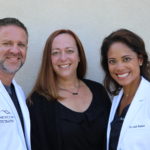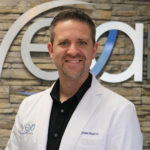
Dr. Swatts with Practice Administrator Amanda Olinger, center, and practice partner and wife, Leah Ramos, OD, right. Dr. Swatts says hiring a practice administrator improved the patient experience and delivered an impressive return on investment.
By Shane Swatts, OD
March 9, 2022
The right investments in your practice can change how you care for patients, the experience they have in your office and the level of profitability you are able to reach. Here are a few investments that made a tremendous difference to our patients and practice.
Hiring a Seasoned Administrator with a Background in Healthcare
With the minimal-to-no business training received at most optometry schools, many doctors who choose to start their own practice, or purchase an existing practice, are thrown into the management side of practice ownership largely unprepared. After attempting to operate our practice on our own, between seeing patients, my practice partner and wife, Leah Ramos, OD, and I realized it was impossible to grow the practice and focus on processes, systems, strategic planning, protocols and ongoing team training while spending most of our time in an exam room.
We made it work for a time, but not at the high level that we desired and at the expense of family time and personal time. Growing a practice while sacrificing quality of life was not our plan. So, we course-corrected and made the decision to hire a professional who could bridge the gap – an administrator with a strong background in billing, coding, insurance, finance, taxes and leadership.
Hiring a professional administrator was a tough decision initially. As with most things, you get what you pay for and this was an area where we were not willing to compromise. We viewed it as an essential investment in our practice, our team and ourselves. We set out to hire someone who knew more than we knew about operating a business.
ROI: Expect to spend $80,000- $120,000 for an experienced practice administrator. Our net income increased 120 percent following the hiring of a practice administrator due to decreased debt, tax planning and by cutting out unnecessary spending.
This investment paid for itself within the first few months. One of the first moves our administrator made was to bring our billing in-house (we had been outsourcing for years). In doing so, our administrator was able to clean up accounts receivables, resubmit claims that had been left sitting and, as claims started to be submitted immediately (rather than on another company’s schedule), we started getting paid quicker.
With the business side of the practice now in the hands of a professional, we were able to invest our time into team training, improving our service principles, redefining our culture, improving efficiency and giving the time and attention to creating the patient experience. This investment went far beyond improving finances. It transformed many areas of our practice because we began to have the time to invest in areas that we could not while in the chaos of trying to run a business and provide a high level care.
Investing in people can be a scarier proposition than investing in inanimate objects like equipment. We had to get past the fear of letting go – the “control factor” that is innate to many private practice owners. This was tough for us in the beginning, but once the bond of trust and open communication is established, it is exhilarating to realize that you have time to focus on the small things (which are the big things) while there is a trusted eye on the business side of the practice.
Adding Intense Pulsed Light Technology
Last year, we added OptiLight from Lumenis for the treatment of dry eye associated with meibomian gland disease (MGD).
We were growing frustrated with the options we had available for treating dry eye disease (DED). Steroids and immunomodulators are a mainstay in therapy and undoubtedly have their place in DED care, but often those treatments did not provide the symptomatic relief or clinical improvement that we, and our patients, desired. Many of our patients would show marginal and temporary progress, but the ongoing cycle of adding more drops, adjusting medication and not having the tools needed to address the root causes of DES, became galling. We began researching other therapies, including IPL. After choosing to proceed with IPL, we went all-in and decided to create MedSpa with OptiLight as a foundational treatment.
We make treating DED a pleasant and memorable experience for our patients. We redesigned three of our nine exam lanes that were situated at one end of the office to create the MedSpa. This involved up-scaling the area with granite countertops, spa chairs and other amenities that lend themselves to a spa-like environment.
Other Articles to Explore
This technology cost us under $100,000, and was purchased via a loan. It took us just four months to pay off our initial investment. We have been consistently turning a profit from use of the technology since that time.
ROI: In the first six months, we averaged $13,000-$15,000 per month in the MedSpa (this was with me doing two days/week and Dr. Ramos doing two days/week). This was starting with zero MedSpa patients, so as time has passed, that profitability number has increased dramatically. Since April 2021, IPL technology has generated $152,607.89 in our practice.
IPL transformed our practice in many ways. First, being able to provide our patients with a natural, light-based treatment that addresses the underlying causes of DED elevated our practice status and placed us among the growing percentage of ODs providing advanced ocular surface disease (OSD) treatments. Secondly, having the ability to not only make our patients feel better, but look better, has been an unexpected, but welcomed consequence which has also shifted our thinking around OSD and made us more mindful of the aesthetic downsides of OSD, and the benefit of IPL.
As a practice we always stocked artificial tears, heat masks, nutraceuticals and other home therapies, but were never great at recommending these treatments. This inventory would often sit for long periods of time. This was also the case with thermal treatments that we offered (Lipiflow and iLux). Once adding IPL, and packaging our treatments to include all of the above, our profit from the sale of home therapies and thermal treatments skyrocketed. Every patient who comes through the MedSpa, when indicated, leaves with tears, a mask, nutraceuticals and scheduled thermal procedures along with IPL.
Another unexpected revenue stream has come from adding a skin care line. With the introduction of IPL, the conversation around skin care is a necessary and seamless part of treatment. As such, we chose a well known, clean skin care line for post-IPL skin care, which we apply in-office. When patients returned for their next visit, we would often get the question, “What did you use on my skin last time and where do I get it?” So, we decided to inventory Epionce products and provide a “rejuvenation kit” that each patient is provided at their first IPL session.
Automation & Use Greater Use of Online Technologies
We started automating as much as we could to provide a seamless experience and save staff time.
Our general philosophy as practice owners is “Automate, Delegate, Eliminate.” We continually evaluate our processes and identify areas of friction or areas where there is a substantial time investment for our staff. From there, we ask, “How can this be automated?” If it can’t, then we ask “Can this be delegated?” If it can’t, we ask “Can this be eliminated?” If it can be eliminated, it is, if it cannot be, it is left to the owners and administrator to oversee and manage.
Technology allows for so much of what has traditionally taken valuable staff time to be automated, freeing them to focus on patient service. We automated online registration and patient forms, and added online real-time appointment scheduling (not an appointment request), online triage for urgent and emergent requests, online contact lens ordering and online payments.
Our policy and procedure manual, ongoing staff training and clinical protocols are all available through an online learning program called TalentLMS, accessible via computer or phone. This way, we can update information in real-time without having to reprint or modify a clunky binder. Training through this software is gamified, so staff compete to see who can learn the most. The top learners earn prizes at the end of the year. We can easily check to see who is taking assigned courses and who is not. We can design our own courses specific to our office or use a prefabricated library of courses for topics such as teamwork, dealing with an angry patient and the importance of using the right words, among other topics.
Further, we automate pre- and post-treatment recommendations, treatment plans, dry eye-specific intake forms, dry-eye questionnaires and post-appointment reviews. For staff anniversaries and birthdays, we use an online awards network. Our team members get “points” depending on the occasion and can go online and choose from a huge selection of both common and unique items (no dollar amount is attached, so there is no worry about one staff member comparing their amount to another).
Most of the automation software/programs that we use have monthly fees ranging from $15 to $150.
ROI: Automation and greater use of online technologies saves us approximately $36,000 annually (additional employees would be needed for scheduling, forms and other functions performed by the technology).
Once we are convinced that a particular automation or online program is working the way we intended and seeing results, we move from monthly billing to annual billing, which typically saves significant money. It is paid out of our ongoing operating expenses.
Patient feedback has been positive and staff has more time to focus on what is in front of them–patients in the office–rather than being tied down with tedious paperwork, scanning and other tasks. Our average patient wait time is five minutes and there are no forms to complete when patients arrive at our office. Patients have a better experience in our office, giving them more reason to return and tell their friends and family about their experience.
 Shane Swatts, OD, is the owner of Eastern Virginia Eye Associates and The MedSpa at EVEA in Chesapeake, Va. To contact him: drswatts@evea2020.com
Shane Swatts, OD, is the owner of Eastern Virginia Eye Associates and The MedSpa at EVEA in Chesapeake, Va. To contact him: drswatts@evea2020.com





















